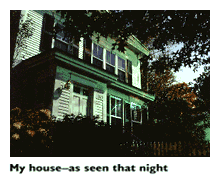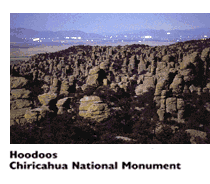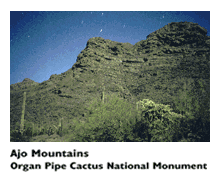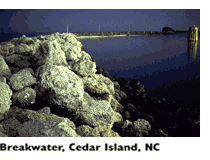
 I started to wonder why, if I could see clearly enough to walk through the forest, I couldn't photograph that same forest under similar conditions. The simple fact is that landscapes can be photographed using moonlight, provided you learn afew important techniques and have the right equipment for the job. Just as your eyes adjust to moonlight and allow you to see almost as well as in daylight, a camera can do a very good job exposing film using only the light of the moon.
I started to wonder why, if I could see clearly enough to walk through the forest, I couldn't photograph that same forest under similar conditions. The simple fact is that landscapes can be photographed using moonlight, provided you learn afew important techniques and have the right equipment for the job. Just as your eyes adjust to moonlight and allow you to see almost as well as in daylight, a camera can do a very good job exposing film using only the light of the moon.| | TRIPOD Wood or large metal tripods work best. I have used large Bogen tripods andmedium-sized Sliks; both have performed admirably when all screws weretightened to the maximum.  People that I have introduced to these techniques who have used small aluminumtripods have not alwaysbeen satisfied with their performance. I strongly encourage investing inas sturdy a tripod as youcan afford if you intend to attempt this sort of photography regularly. People that I have introduced to these techniques who have used small aluminumtripods have not alwaysbeen satisfied with their performance. I strongly encourage investing inas sturdy a tripod as youcan afford if you intend to attempt this sort of photography regularly.I use my Nikon F3HP, exclusively, for moonlight photography. The moremanual your camera, the better. The most difficulty I have ever witnesseda photographer havewas experienced by a friend accompanying me in North Carolina as hestruggled to make hisNikon N90 accept the length of exposures he was attempting to program intoit. |
| | LENSES I bring a variety of lenses with me, ranging from a 35mm f2.0 to a 300mm f4.5.Use whatever lenses you already own and are comfortable with. Although thefaster your lensesare the less time you will actually have to spend photographing, speed isnot your most importantconsideration. |
| | FILM Contrary to what logic may suggest, in this case, faster isnot better! I cannotoveremphasize this. To spend hours of your night photographing a beautifulscene only to havethe images come back grainy is not acceptable.  The time you save with faster films will not beenough to make it worth your while. There are only a few films that Iwould consider: Kodachrome and theslower Fuji slideemulsions. The time you save with faster films will not beenough to make it worth your while. There are only a few films that Iwould consider: Kodachrome and theslower Fuji slideemulsions. |
| | MISCELLANEOUSEQUIPMENT The above items, plus a high-quality cable lock (I haveseen three cable locks fall apart and instantly finish these outings), areall of the photographicequipment needs that you will have. I do not recommend using filters toget around reciprocityissues or for any other reason. The exposures are too long and youare likely to getdisturbing or confusing "ghosts" of reflective light sources that you didnot see when you framedthe image. Each time you go out for a moonlight shoot, as for anyimportant shoot, you should ensure that you have plenty of fresh batterieson hand to keep your camera's shutter functioning. This is particularlyimportant if you use an automated camera which has a high electricity andbattery demand. |
| | NON-PHOTOGRAPHICEQUIPMENT There are a number of non-photographic needs thatshould be addressed. The first of these is a source of light beyond thatof the moon, for your ownuse and safety. You must safely get to the spot where you plan to takeyour photos. In addition,you must be able to choose apertures, change lenses, and so forth, inbetween shots. If youchoose to photograph smaller details of your scene, you will need toilluminate these in order tofocus. Having tried many different types of light sources, Iwholeheartedly recommend the use ofa headlamp. You will need a watch or a stopwatch of some sort to time yourexposures.  |
 The light is best for your purposes starting about two tothree hours after the moon rises. At this time, it will be high enough inthe sky to fully light yourscene, without losing shadows, which will happen when it is directlyoverhead. This ideal time to shoot may occur at any time of the night,depending upon what time the moon rises. You will find that some months itis not possible to shoot at all because the moon rises extremely late orduring the daylight hours. Check theweather section of your newspaper to determine moonrise times.
The light is best for your purposes starting about two tothree hours after the moon rises. At this time, it will be high enough inthe sky to fully light yourscene, without losing shadows, which will happen when it is directlyoverhead. This ideal time to shoot may occur at any time of the night,depending upon what time the moon rises. You will find that some months itis not possible to shoot at all because the moon rises extremely late orduring the daylight hours. Check theweather section of your newspaper to determine moonrise times.
 Color slide film always sees in color, regardless of whatthe photographer perceives with her brain.
Color slide film always sees in color, regardless of whatthe photographer perceives with her brain.  In your first outings, while you learn about super-longexposures and thecompositional elements within them, you are likely to have few great images. But you will see inthose images a world that is entirely different from the one you perceivewhen you look at it -- indaylight or at night. As a photographer who strives to see and capture thebeauty present in thenatural world, I think that one of the greatest rewards is to see, todiscover, a new beauty that hadbeen hidden.
In your first outings, while you learn about super-longexposures and thecompositional elements within them, you are likely to have few great images. But you will see inthose images a world that is entirely different from the one you perceivewhen you look at it -- indaylight or at night. As a photographer who strives to see and capture thebeauty present in thenatural world, I think that one of the greatest rewards is to see, todiscover, a new beauty that hadbeen hidden. 